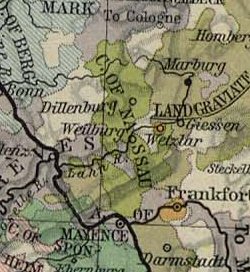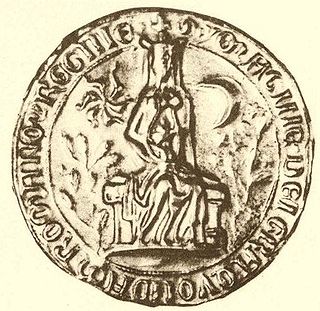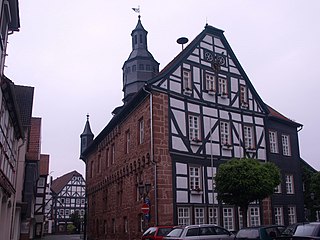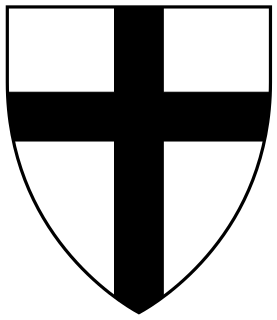
Adolf was Count of Nassau from about 1276 and elected King of Germany from 1292 until his deposition by the prince-electors in 1298. He was never crowned by the Pope, which would have secured him the title of Holy Roman Emperor. He was the first physically and mentally healthy ruler of the Holy Roman Empire ever to be deposed without a papal excommunication. Adolf died shortly afterwards in the Battle of Göllheim fighting against his successor Albert of Habsburg.

The County of Nassau was a German state within the Holy Roman Empire and later part of the German Confederation. Its ruling dynasty, the male line of which is now extinct, was the House of Nassau.

Nassau Castle, located in Nassau, Rhineland-Palatinate, Germany, was the original seat of the House of Nassau. The ruins of the castle are situated on a rock outcropping about 120 m (390 ft) above the Lahn River. The House of Nassau was an aristocratic dynasty among whose descendants are the present-day monarchy of the Netherlands and Luxembourg.
Walram II of Nassau was Count of Nassau between c. 1249 and 1276.
Henry II the Rich was Count of Nassau between 1198 and 1249.
Gerlach I of Nassau, Count of Nassau in Wiesbaden, Idstein, Weilburg, and Weilnau.
John I of Nassau-Weilburg (1309–1371) was Count of Nassau-Weilburg from 1355 to 1371.

Imagina of Isenburg-Limburg was the Queen consort of Adolf of Nassau, King of Germany.

Sonnenberg is a borough of Wiesbaden, the capital of the state of Hesse, Germany. Formerly an independent municipality, Sonnenberg was incorporated into Wiesbaden on 28 October 1926. The borough has approximately 8,000 residents.
Dudo of Laurenburg(German: Dudo von Laurenburg, Latin: Tuto de Lurinburg, † before 1124), was probably count of Laurenburg and is considered the founder of the House of Nassau. The House of Nassau would become one of the reigning families in Germany, from which are descended through females the present-day royals of the Netherlands and Luxembourg, while officially belonging to this House.
Rupert I of Laurenburg, German: Ruprecht von Laurenburg, was count of Laurenburg and one of the ancestors of the House of Nassau.
Arnold I of Laurenburg, was count of Laurenburg and an ancestor of the House of Nassau.
Walram I of Nassau was the first Count of Nassau, reigning from 1154 to 1198. The House of Nassau would become an important aristocratic family in Germany, from which are descended the present-day rulers of both the Netherlands and Luxembourg.
Rupert III "the Bellicose" of Nassau, German: Ruprecht III. "der Streitbare" von Nassau, was one of the earliest counts of Nassau. He took part in the Third Crusade.
Mechtild of Nassau was the youngest child of Adolf of Germany and his wife Imagina of Isenburg-Limburg. Mechtild is also known as Matilda of Nassau. She was Duchess consort of Bavaria, by her marriage to Rudolf I, Duke of Bavaria.
Count John of Nassau-Idstein was Count of Nassau and Protestant Regent of Idstein.
Adolph II, Count of Nassau-Wiesbaden-Idstein was a son of Walram IV, Count of Nassau-Idstein his wife, Bertha of Westerburg. He married in 1418 with Margaret (1404–1442), a daughter of Bernard I, Margrave of Baden-Baden. After his father's death in 1393, he ruled Nassau-Wiesbaden and Nassau-Idstein.
Adolph I, Count of Nassau-Wiesbaden-Idstein was a son of Count Gerlach I and Agnes of Hesse. In 1344, his father abdicated in favor of his sons. They ruled jointly until 1355, then divided their inheritance:
















